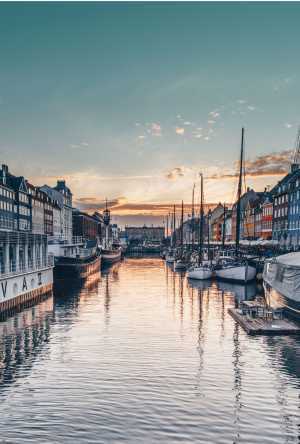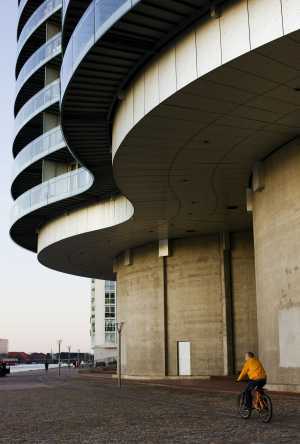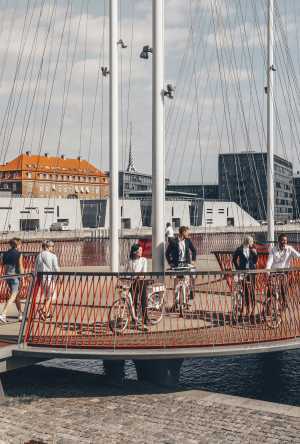I'm convinced that the sky looks bluer in Copenhagen. Now, it could be that I’ve got my azure-coloured holidaymaking glasses on. Or that I’ve just lucked out with a sun-soaked summer weekend in a Scandinavian city that’s notorious for its cold, wet and moody weather.
That’s the Copenhagen I know from a decade ago, when I was last in the city completing a year abroad. I’m back now to reunite with a dozen-strong group of exchange student friends who have flown in from across Europe (including all of Prague, Hamburg, Geneva, Munich) and as far as Melbourne for the occasion.
Getting There
Air Canada and SAS fly directly from Toronto to Copenhagen in 7 hours and 30 minutes. Return tickets start at $1,200. Bycyklen, electric-powered bikes, can be rented at over 100 stands across the city.
But it’s not only these familiar faces that I’m meeting again. I’m also reuniting with a city whose bike-lane-lined streets, colourfully charming facades and unpronounceable language were once my everyday. It’s not my home anymore, but I don’t feel completely out of place.
My favourite landmarks, thankfully, still stand. From historic sites like the twisting spiral staircase on the spire of Vor Frelses Kirke and the cobblestoned main pedestrian strip, Strøget, where I held a part-time job at one of the first Urban Outfitters in Europe (I’m convinced they only hired me for my American-sounding accent) to contemporary structures like the Royal Library of Denmark, where I used to study for exams. It still overlooks the harbour with its polished, black granite exterior that juts out at irregular angles, earning it the nickname “Den Sorte Diamant”, or the Black Diamond. It accompanies a collection of modern buildings along the harbour: The playhouse, opera house and theatre.
We even managed to sneak into the dormitory I once lived in – Bikuben Kollegiet. Ours was the first round of students to live in the brand-new building, which itself was such a marvel in design that I would frequently run into groups of architecture students touring the space.
But like any progressive city, there’s plenty that’s changed since I left. Just south of Bikuben, a former industrial region of abandoned warehouses and silos (where I attended the occasional rave during my year in Copenhagen) is now a revived district of both new apartments and old factories repurposed into trendy residences.
Copenhagen native Andreas Hansen lives in one of them. Wennberg Silo, a former soybean processing plant built in the 1950s, stood vacant for decades before it was renovated for residential living in 2004.
Hansen has been renting here since 2009 and his apartment spans between two former silos – a living room and kitchen in one connected to a bedroom and office – all of which look out into the harbour. Situated on the second floor of the building, he’s not far from the water. In fact, standing in the middle of his living room, he says, it looks and feels like you’re on a boat.
Also visible from Hansen’s apartment is Langebro, the main bridge connecting Amager Island (where you’ll find Hansen’s building and my old dormitory) to the main city. It’s where we find ourselves traversing by rented city bike on our first full day in the city, with the sun still streaming down.
I’VE LUCKED OUT WITH A SUN-SOAKED WEEKEND IN A CITY THAT’S NOTORIOUS FOR ITS COLD, WET AND MOODY WEATHER
In light of the fortuitous weather we have donned our bathing suits and flocked to the water, where reflections of the sky’s cerulean hue seem to deepen. We’ve set up our makeshift camp of towels and blankets along a grassy expanse on the western coast of Amager Island, not far from Wennberg Silo.
At this man-made harbour bath, we’re joined by a healthy gathering of both local Copenhageners and tourists. The harbour park, which opened in 2002, quickly became a popular spot to enjoy a refreshing dip in the seawater-fed harbour.
I didn’t think that I would have the opportunity to work on my tan in one of the northernmost countries I’ve ever visited. But here I am, sizzling in my swimmers. A Vancouverite in the group, who has since relocated to Oslo to be with his Norwegian wife, reminds me that the rays up north are stronger than you’d think. I dutifully slather on SPF 60 as I’m squinting in the sunlight.
While I’m soaking in these unexpected rays, the more adventurous members of the group are waiting in line for their turn to cannonball off a platform set out in the harbour. It’s another fine display of Scandinavian design – a triangular structure modeled after the hull of a ship. At a safe distance from the platform, children swim in shallow zones while others practice their freestyle stroke along a separate lane.
Copenhagen has a long history of harbour swimming, with open-air bathing houses dating back to the 1800s. But as the city’s manufacturing and shipping industries grew through the 19th and 20th centuries, the water became murky and heavily polluted with toxic chemicals and harmful microorganisms by the 1980s.
Copenhagen’s main container ports, dockyards and manufacturing hubs were moved to newer facilities outside of the city, and officials saw the opportunity to transform the harbour into a liveable, swimmable area for all.
Wastewater systems were modernized and the water was painstakingly cleaned. By 2002, the city opened its first harbour bath on Amager Island followed by three more public baths between 2002 and 2011.
An important part of the harbour revitalization was the construction of several pedestrian and bicycle-only bridges that connect Amager Island with the city centre, making it easier for Copenhageners to access the baths and spend time along its recently revitalized waterways.
These bridges are a nice example of how the city takes any and all opportunity to make a functional item fashionable. Mast-like structures on the Circle Bridge, which opened just two years ago, harken back to the city’s history as a shipping port. The staggered, snaking circles also cleverly force speedy cyclists to slow down while they’re biking alongside pedestrians.
These developments have created a new distinctive identity for Copenhagen that combines the city’s fairytale-like street scenes (it is, after all, the birthplace of author Hans Christian Andersen) with striking monuments to modernity.
New residential areas have mainly expanded south of the city to Sydhavnen, where ground-level apartment units are have docks set directly in the harbour. But another former industrial district in the northeast corner of Copenhagen – a bankrupt shipyard – is on the brink of transformation.
A short, 15-minute cycle from the city centre (yes, here distances are measured by minutes spent on a bike) gets us to Refshaleøen. This is where we find ourselves on the second day of our trip and our continued hunt for seaside revelry.
In contrast to the tight, cozy cobblestone streets and bustling city, Refshaleøen retains the rugged industrial atmosphere of its former life. Disused shipping containers are stacked next to vacant graffitied buildings and boarded-up windows.
Like any gentrifying district, Copenhagen’s trendiest operations are quickly springing up here. The Michelin-starred Amass Restaurant, from former Noma head chef Matt Orlando, set up shop here in 2013 and earlier this year, Noma themselves launched their much-anticipated second location on the industrial island.
Owners of the acclaimed Italian restaurant Il Buco opened their own seaside shack, La Banchina, in a former waiting room for ferry passengers. The café sits on cottage-country-esque piers set in a quieter cove off the main harbour. When the sun is shining, space on these docks is harder to come by than a patch of spare grass at Toronto’s Trinity Bellwoods Park.
The locals are still finding their way around here, it seems, as a middle-aged Copenhagener stops to ask us for directions, unaware of the fact that we are ourselves attempting to orientate. Matters are made worse by the fact that nearly all the streets on this island are named “Refshalevej.”
NEARLY ALL THE STREETS ON THIS ISLAND ARE NAMED “REFSHALEVEJ”
It’s easy to miss the turnoff from the road (one of the many Refshalevejs we cycle through) to our destination but a keen eye from our group spots a ramshackle sign pointing to an opening in a wooden fence that we carefully clamber through.
The sound of low-key house beats gets louder as we cycle down the lane – we’re heading in the right direction. Unlike yesterday’s family-friendly day in the sun, we’ve chosen to spend our last day together at Halvandet – which is best described as Copenhagen’s closest equivalent to a glitzy, Ibiza-like beach club.
We sprawl out on cushy king-sized sun loungers and pitch in for bottles of rosé for the group, a rare moment where I allow myself to forget the pricey conversion rates from dollars to krone. Grains of sand from Halvandet’s man-made beach volleyball courts are stuck between my toes.
We linger at Halvandet for hours until the sky develops a pink complexion not unlike the wine we’ve drunk, reflected in the blue harbour that for a moment glows with the warmth that I feel for this city.



